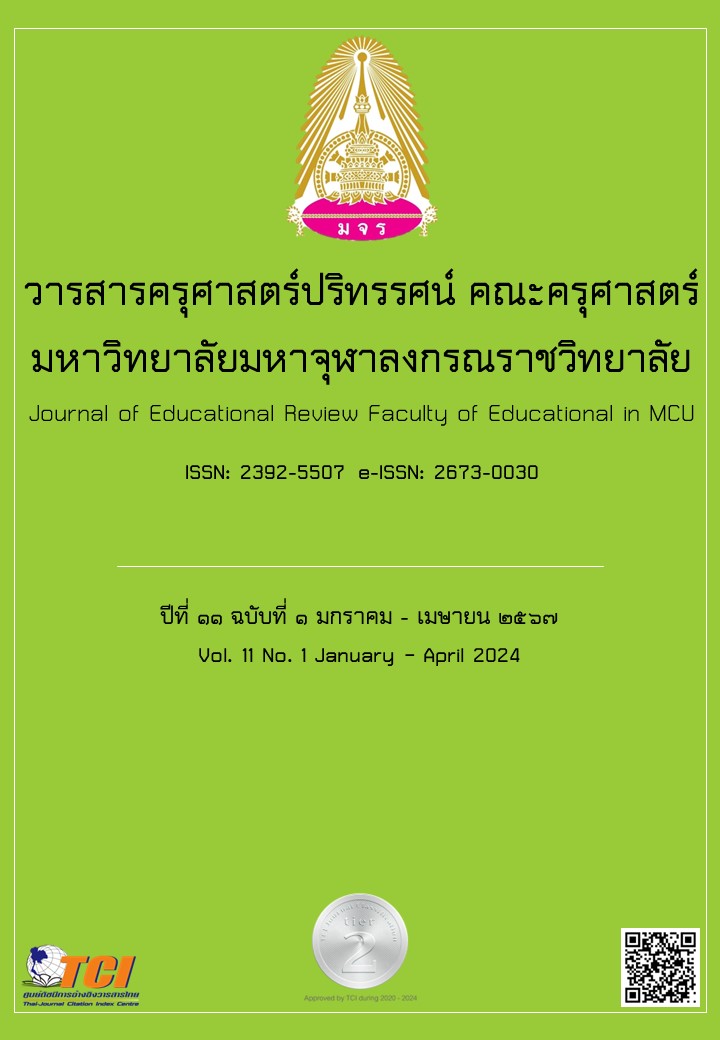THE MANAGEMENT OF DEVELOPMENT MODEL FOR THE CIVILIZED AGRICULTURE CURRICULUM: CONTINUING, MAINTAINING, EXTENSION RELATED TO THE ROYAL VIEW IN AN ECONOMIC SUFFICIENCY BASED ON “KOK NONG NA” WITH KINDNESS AND HOPE, FOR STUDENT QUALITY DEVELOPMENT IN RAJAPRAJANUGROH 39 SCHOOL, NARATHIWAT UNDER THE SPECIAL EDUCATION BUREAU
Main Article Content
Abstract
The objective of this research article was to develop the management of development model for the civilized agriculture curriculum: continuing, maintaining, extension related to the royal view in an economic sufficiency based on “Kok Nong Na” with kindness and hope, for student quality development in Rajaprajanugroh 39 School, Narathiwat under the Special Education Bureau. The research procedure was divided into 4 phases. Phases: 1) to study the present circumstance and guidelines of the civilized agriculture curriculum Management. Phases: 2) to develop the model for the civilized agriculture curriculum, Phases: 3) to study the results of the experiment using the model for the smart civilized agriculture curriculum and phases: 4) to evaluate the satisfaction of users of the management of development model for the civilized agriculture curriculum. The sample group used in the quantitative study was the deputy director, 141 school teachers, and the qualitative research informants were Group 1: 2 school administrators, 2 learning center advisors, 1 representative of local philosophers and another group was assessing the satisfaction of 156 students in Mathayomsuksa 4-6 of Ratchaprachanukroh School 39, Narathiwat Province. The research tools were questionnaires, interviews, satisfaction assessment forms then data were analyzed using basic statistics and content analysis. The results of the research found that: 1) Overall management conditions of the civilized agriculture curriculum were practiced at a high level. 2) The results of the development of the administrative model for the Agricultural Civilization Curriculum consisted of 3 components: Component 1: management of development model for the civilized agriculture curriculum: continuing, maintaining, extension related to the royal view in an economic sufficiency based on “Kok Nong Na” with kindness and hope, namely (1) the continuation side had 10 indicators, (2) treatment side had 7 indicators, (3) expansion side had 7 indicators. Component 2: The administrative process of the civilized agriculture curriculum was (1) planning had 7 indicators, (2) organizing had 6 indicators, (3) leading had 6 indicators, (4) controlling had 7 indicators. Component 3 was the creation of a collaborative network and the results of the trial of the model were that students received awards for learner quality, including (1) Academics, the secondary school level used the civilized agriculture curriculum, type B model, 2) Professional aspect: having skills in taking action until it was effective and applying knowledge to solve problems, skills in transferring knowledge of farmers way of life according to the learning center where the school had organized in order to lead to practice that was abstract practice to community and society, 3) Life subjects: having a good attitude towards the royal initiative, having morality, ethics, be grateful and responsible. 3) The results of the satisfaction assessment of users of the civilized agriculture curriculum management model, including the deputy director, teachers and personnel, and students were at the highest level of satisfaction in both groups.
Article Details

This work is licensed under a Creative Commons Attribution-NonCommercial-NoDerivatives 4.0 International License.
ทัศนะและความคิดเห็นที่ปรากฏในบทความในวารสารฉบับนี้ถือเป็นความรับผิดชอบของผู้เขียนบทความนั้นเพียงผู้เดียว และไม่ถือเป็นทัศนะและความรับผิดชอบของกองบรรณาธิการ
กองบรรณาธิการขอสงวนสิทธิ์ในการคัดเลือกบทความลงตีพิมพ์และจะแจ้งให้เจ้าของบทความทราบหลังจากผู้ประเมินบทความตรวจอ่านบทความแล้ว
ต้นฉบับที่ได้รับการตีพิมพ์ในวารสารครุศาสตร์ปริทรรศน์ คณะครุศาสตร์ มหาวิทยาลัยมหาจุฬาลงกรณราชวิทยาลัย ถือเป็นกรรมสิทธิ์ของคณะครุศาสตร์ มหาวิทยาลัยมหาจุฬาลงกรณราชวิทยาลัย ห้ามนำข้อความทั้งหมดหรือบางส่วนไปพิมพ์ซ้ำ เว้นเสียแต่ว่าจะได้รับอนุญาตจากมหาวิทยาลัยฯ เป็นลายลักษณ์อักษร
References
กระทรวงศึกษาธิการ. (2545). พระราชบัญญัติการศึกษาแห่งชาติ พุทธศักราช 2542 (ฉบับที่ 2) และที่แก้ไขเพิ่มเติม พุทธศักราช 2545. กรุงเทพมหานคร: สยามสปอรต์ ซินดิเคท.
กระทรวงศึกษาธิการ. (2557). นโยบายด้านการศึกษารัฐมนตรีว่าการกระทรวงศึกษาธิการ. แหล่งที่มา http://www.bic.moe.go.th/th/index.php. สืบค้นเมื่อ 1 ก.พ. 2562.
จรูญ วัฒนา. (2552). การบริหารสถานศึกษาสู่ความเป็นเลิศ. แหล่งที่มา https//www.gotoknow.org/posts/320364. สืบค้นเมื่อ 30 มี.ค. 2563.
ปาริชาติ สันติเลขวงษ์. (2565). การพัฒนารูปแบบการบริหารสถานศึกษาขั้นพื้นฐานในภาคตะวันออกตามแนวทางหลักปรัชญาของเศรษฐกิจพอเพียง. ดุษฎีนิพนธ์ปรัชญาดุษฎีบัณฑิต. มหาวิทยาลัยศิลปากร.
เปรม เดชแก้ว และคณะ. (2565). การพัฒนารูปแบบการบริหารจัดการศูนย์การเรียนรู้ตามหลักปรัชญา ของเศรษฐกิจพอเพียงด้านการศึกษา ของโรงเรียนมัธยมศึกษาในจังหวัดชุมพร สังกัดสำนักงานเขตพื้นที่การศึกษามัธยมศึกษาสุราษฎร์ธานี ชุมพร. วารสารวิชาการมหาวิทยาลัยราชภัฏเพชรบุรี. 12(3). 72-80.
พระปลัดสำราญ ฐานธมฺโม และคณะ. (2565). รูปแบบเกษตรอินทรีย์วิถีโคกหนองนาโมเดล:รูปแบบชุมชนสันติสุขของบ้านถ้ำโกบ ตำบลหน้าเขาอำเภอเขาพนม จังหวัดกระบี่. วารสารสันติศึกษาปริทรรศน์ มจร. 3(1). 365-376.
พิมพันธ์ เตชะคุปต์. (2558). การจัดการเรียนรู้ในศตวรรษที่ 21. พิมพ์ครั้งที่ 2. กรุงเทพมหานคร: โรงพิมพ์แห่งจุฬาลงกรณ์มหาวิทยาลัย.
วราภรณ์ บุญเพชร. (2565). การนำแนวความคิดเศรษฐกิจพอเพียงไปปฏิบัติผ่านโครงการ “โคก หนอง นา” กรณีศึกษาพื้นที่จังหวัดระนอง พรก.เงินกู้แก้ไขปัญหาโควิด 2563. วิทยานิพนธ์รัฐประศาสนศาสตรมหาบัณฑิต. มหาวิทยาลัยรามคำแหง.
สมศักดิ์ คงเที่ยง. (2555). หลักบริหารการศึกษา. กรุงเทพมหานคร: พี.เอ.ลีฟวิ่ง.
สำนักงานคณะกรรมการพัฒนาเศรษฐกิจและสังคมแห่งชาติ. (2559). สรุปสาระสำคัญแผนพัฒนาเศรษฐกิจและสังคมแห่งชาติ ฉบับที่ 12 พ.ศ. 2560-2564. กรุงเทพมหานคร: สำนักงานคณะกรรมการพัฒนาเศรษฐกิจและสังคมแห่งชาติ.
สำนักงานเลขาธิการสภาการศึกษา. (2560). แผนการศึกษาแห่งชาติ พ.ศ.2560 - 2579. กรุงเทพมหานคร: พริกหวานกราฟฟิค.
อลิสา อินทร์ประเสริฐ และคณะ. (2564). การพัฒนารูปแบบการบริหารศูนย์การเรียนรู้ตามหลักปรัชญาของเศรษฐกิจพอเพียงของสถานศึกษาในภาคตะวันออก สังกัดสำนักงานคณะกรรมการการศึกษาขั้นพื้นฐาน. วารสาร e-Journal of Education Studies, Burapha University. 4(3). 15-30.
Krejcie, R.V. & Morgan, D.W. (1970). Determining Sample Size for Research Activities. Educational and Psychological Measurement. 30(3). 607-610.
Markusen, A. (2004). Targeting Occupations in Regional and Community Economic Development. Journal of the American Planning Association. 70(3). 253-268.


